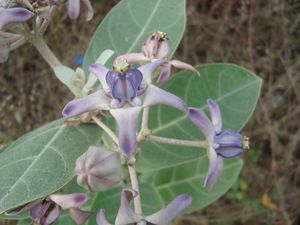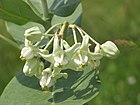Note: This is a project under development. The articles on this wiki are just being initiated and broadly incomplete. You can Help creating new pages.
Difference between revisions of "Calotropis gigantea - Arka plant"
(→Commonly seen growing in areas) |
(→References) |
||
| Line 62: | Line 62: | ||
<references> | <references> | ||
<ref name="Leaf">[https://keyserver.lucidcentral.org/weeds/data/media/Html/calotropis_procera.htm "queenland govt"]</ref> | <ref name="Leaf">[https://keyserver.lucidcentral.org/weeds/data/media/Html/calotropis_procera.htm "queenland govt"]</ref> | ||
| − | <ref name="How to plant/cultivate">[http://tropical.theferns.info/viewtropical.php?id=Calotropis+gigantea " | + | <ref name="How to plant/cultivate">[http://tropical.theferns.info/viewtropical.php?id=Calotropis+gigantea "Cultivation Details"]</ref> |
| − | <ref name="Uses">[https://www.bimbima.com/herbs/medicinal-uses-of-madar-or-arka/688/ " | + | <ref name="Uses">[https://www.bimbima.com/herbs/medicinal-uses-of-madar-or-arka/688/ "Medicinal uses of Madar"]</ref> |
</references> | </references> | ||
Revision as of 13:23, 2 May 2018
It is a large shrub growing to 4 m (13 ft) tall. It has clusters of waxy flowers that are either white or lavender in color. Each flower consists of five pointed petals and a small "crown" rising from the center which holds the stamens. The aestivation found in calotropis is valvate i.e. sepals or petals in a whorl just touch one another at the margin, without overlapping. The plant has oval, light green leaves and milky stem. The latex of Calotropis gigantea contains cardiac glycosides, fatty acids, and calcium oxalate.
Contents
Uses
Rheumatism, painful joints, Skin blemishes, Leucoderma, vitiligo, Piles, Pain in ears[1]
Parts Used
Root, Bark, Flowers, Leaf, Latex.
Chemical Composition
The milky sap contains a complex mix of chemicals, some of which are steroidal heart poisons known as "cardiac aglycones". These belong to the same chemical family as similar chemicals found in foxgloves (Digitalis purpurea). The steroidal component includes an hydroxyl group in the C3β position, a second attached to the C14 carbon, a C/D-cis ring junction and an α,β-unsaturated-γ-lactone in the C17 position. In the plants, the steroidal component is commonly attached via a glycosidic link to a 2-desoxy or a 2,6-didesoxy sugar molecule
Common names
| Language | Common name |
|---|---|
| Kannada | Ekka, Ekkagida |
| Hindi | Ak, Akada, Safed-ak |
| Malayalam | Erikku |
| Tamil | Vellaerukku |
| Telugu | Nallajelledu, Mandaramu |
| Marathi | NA |
| Gujarathi | NA |
| Punjabi | NA |
| Kashmiri | NA |
| Sanskrit | Swetarka, Arka, Ravi |
| English | Madar |
Habit
Identification
Leaf
| Kind | Shape | Feature |
|---|---|---|
| milky white sap | large, relatively thick (5-30 cm long and 4-15 cm wide) | The leaves greyish-green in colour and have entire margins |
.[2]
Flower
| Type | Size | Color and composition | Stamen | More information |
|---|---|---|---|---|
| borne in clusters | 15-25 mm across | white or pinkish | five | Flowering occurs mostly during winter. |
Fruit
| Type | Size | Mass | Appearance | Seeds | More information |
|---|---|---|---|---|---|
| large | 6-12 cm long and 3-7 cm wide | These fruit have thick and spongy skins which split open at maturity | numerous brown, flattened seeds | {{{6}}} |
Other features
List of Ayurvedic medicine in which the herb is used
- Vishatinduka Taila as root juice extract
Where to get the saplings
Mode of Propagation
How to plant/cultivate
Succeeds in the drier tropics. Most commonly found in areas of the tropics with a specific dry season, at elevations up to 1,000 metres[3]
Commonly seen growing in areas
trophical, indian subcontinent.
Photo Gallery
References
External Links
- Pages that are stubs
- Ayurvedic Herbs known to be helpful to treat Rheumatism
- Ayurvedic Herbs known to be helpful to treat painful joints
- Ayurvedic Herbs known to be helpful to treat Skin blemishes
- Ayurvedic Herbs known to be helpful to treat Leucoderma
- Ayurvedic Herbs known to be helpful to treat vitiligo
- Ayurvedic Herbs known to be helpful to treat Piles
- Ayurvedic Herbs known to be helpful to treat Pain in ears
- Herbs with Root used in medicine
- Herbs with Bark used in medicine
- Herbs with Flowers used in medicine
- Herbs with Leaf used in medicine
- Herbs with Latex used in medicine
- Herbs with common name in Kannada
- Herbs with common name in Hindi
- Herbs with common name in Malayalam
- Herbs with common name in Tamil
- Herbs with common name in Telugu
- Herbs with common name in Sanskrit
- Herbs with common name in English
- Habit - Large shrub
- Index of Plants which can be propagated by Seeds
- Index of Plants which can be propagated by Cuttings
- Index of Plants which can be propagated by Layering
- Herbs that are commonly seen in the region of trophical
- Herbs that are commonly seen in the region of indian subcontinent
- Herbs









